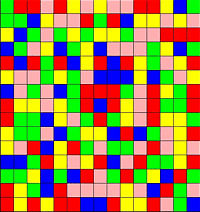SameGame
SameGame is a puzzle game originally invented as Chain Shot! in 1985 by Kuniaki Moribe (Morisuke), which was distributed for Fujitsu FM-8/7 series in a Japanese monthly personal computer magazine called Gekkan ASCII.
 The
game was afterwards re-created under the name of
'SAME GAME' in 1992 for UNIX platforms by Eiji
Fukumoto (Kyoto), followed by the one for NEC PC-9801
series by Wataru Yoshioka (W. Yossy). In 1993 it was
ported to Windows 3.1 by Ikuo Hirohata. This version
was translated into English by Hitoshi Ozawa and is
still available from his software archive. In 1994,
Takahiro Sumiya ported it to Macintosh. This version
has some gameplay differences (three instead of five
colors) and is probably the most widely distributed
of the original series. It was the basis for Same
Gnome/KSame on Linux.
The
game was afterwards re-created under the name of
'SAME GAME' in 1992 for UNIX platforms by Eiji
Fukumoto (Kyoto), followed by the one for NEC PC-9801
series by Wataru Yoshioka (W. Yossy). In 1993 it was
ported to Windows 3.1 by Ikuo Hirohata. This version
was translated into English by Hitoshi Ozawa and is
still available from his software archive. In 1994,
Takahiro Sumiya ported it to Macintosh. This version
has some gameplay differences (three instead of five
colors) and is probably the most widely distributed
of the original series. It was the basis for Same
Gnome/KSame on Linux.
Rules of the Game
There is a rectangular playing screen initially filled with several, typically 4 or 5, kinds of blocks at random. By selecting one of a group of adjoined blocks, a player may remove them from the screen. The blocks on top of the removed group will drop down.
A column without any blocks will be trimmed away by other columns sliding to the left. The game is over if no more blocks can be removed.
Most versions of the game give (n - k)^2 points for removing n tiles at once, where k = 1 or 2 depending on the implementation. For instance, Insane Game for TI calculators uses (n - 1)^2. Ikuo Hirohata's implementation uses the formula n^2 - 3 × n + 4. The Bubble Breaker implementation for Windows Mobile uses the n × (n - 1) formula.
Some versions also offer a large bonus for removing all the blocks on the screen. Yet others reduce the final score based on the number of blocks remaining at the end of the game.
Key Publication
Schadd, M.P.D., Winands, M.H.M., Tak, M.J.W., and Uiterwijk, J.W.H.M. (2012). Single-Player Monte-Carlo Tree Search for SameGame. Knowledge-Based Systems. Vol. 34, pp. 3-11.
